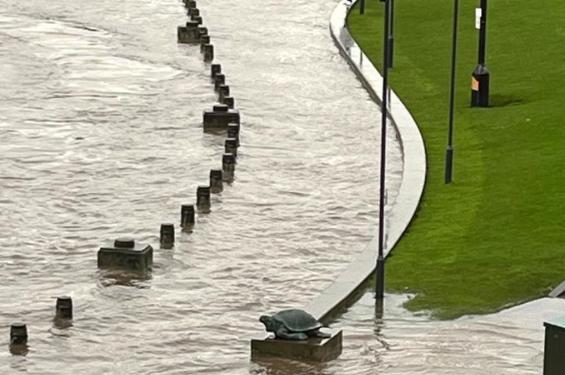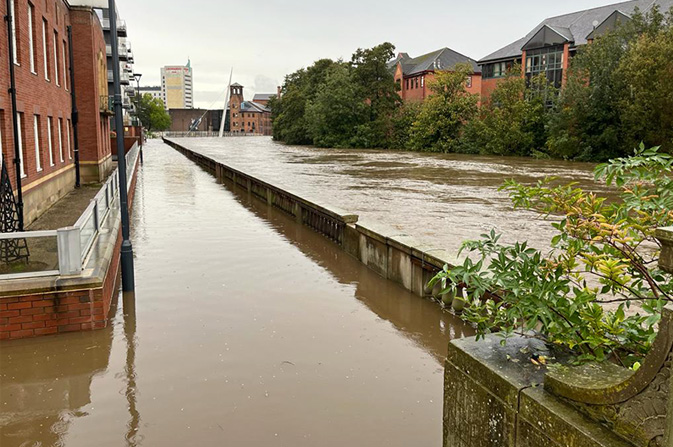Derby has always experienced flooding. As the city grew the river was its strength, as its power was used to drive silk production. But the Derwent has also been Derby’s threat. Official measuring of river levels began in 1935 and reached the highest on record on Saturday 21 October.
Topping out at 3.58m, the previous record from 8 November 2019 was broken. In all, half of the top ten highest river levels recorded in Derby have happened in the past five years. With major flood events becoming more frequent, the city is upping its game to cope with the effects of climate change.
Storm Babet made its mark on Derby with persistent heavy rain causing problems with surface water as well as the river. The result was major disruption on roads around the city centre and flooding to businesses and some homes. However, the latest stage of the Our City, Our River flood defence programme performed well and limited the damage.
The newest addition to the flood defence arsenal, the award winning Mill Fleam Pumping Station, was given its first real-world test. With all three of its pumps in action at the height of the flooding, it performed exactly as designed. Given the amount of water that was pumped out over the weekend, it’s believed the station prevented a huge area of the city centre from flooding.
The story was very different in 1932, the year of the Great Flood. Photographs taken by the Borough Surveyor show people standing up to their knees in floodwater on Sadler Gate. The front page of the Derby Evening Telegraph the following day, 23 May 1932, describes the flooding as the worst since 1842.
The newspaper describes the water as reaching depths of eight feet in some places and puts early costs to the city at £400,000. The Mayor’s Flood Fund was launched, with souvenir pamphlets on sale at 6d each – equivalent to 2.5p today.
Fast forward to October 2023, we have a very different city with a state-of-the-art pumping station. Had it not been constructed, and water had been allowed to flow back up the Markeaton Brook culvert, we could have seen flood waters in the heart of the city once again.

Sadler Gate during the Great Flood of 1932. (Derby Local Studies and Family History Library)
Our flood walls and gates, from Darley Abbey down to the River Gardens, were also called into action to keep water out of the hundreds of riverside properties behind them. The defences contained flood water in an engineered corridor as it flowed through the city, with around 2,000 properties benefiting last weekend.

Flood walls at the River Gardens on 21 October 2023
But flood defences can’t protect places where they’re not built, and the OCOR scheme is not a finished product. Some areas of the city, such as Exeter House and Meadow Road, are still reliant on defences built in the 1960s, which are reaching the end of their useful life and cannot always cope with the flood events we are seeing today.
The planned new defences at Derby Riverside would include higher, more resilient walls running from Causey Bridge down to Derwent Bridge, increasing protection for businesses, homes and infrastructure. A new riverside park opposite the Museum of Making would also provide a wider flood conveyance corridor, providing a space for floodwater to go and get round bridges more quickly. This could potentially reduce the river level around the Museum during a flood event. A planning application for this work has been submitted and is due to be considered soon.
Councillor Carmel Swan, Cabinet Member for Climate Change, Transport and Sustainability, said:
“For the second time in four years Derby has seen new records for river levels. While this is alarming, it is reassuring to know that we have a flood defence network we can count on.
“As a ward councillor of Darley, I know that the community experienced some concerns. However, Darley is a strong community and pulled together to support each other through this challenging time.
“I am extremely proud of this scheme and the teams behind it. The defences have once again proved their worth. I am particularly delighted with the success of the Mill Fleam pumping station, which was given a real baptism of fire but performed as expected under the immense pressure of record-breaking river levels.
“This event also highlighted the need for the completion of package 2 at Derby Riverside, and further protection on the east side of the river. This is currently in the planning application stage, and we are hoping to have a decision soon.”
Councillor Baggy Shanker, Leader of Derby City Council, added:
“Again I would like to thank all the Council teams who continue to work tirelessly to get Derby back up and running after the extreme flooding we saw last weekend. While my heart goes out to anyone who was affected – and we’ll be sharing information about support schemes as and when they become available – it is encouraging to see how well our flood defences have worked. We will continue to work to secure funding to protect our city against the effects of climate change, which is becoming a reality.”
An Environment Agency spokesperson said:
“The rainfall event that we’ve seen over the past few days has been exceptional with rainfall totals across the region the most significant for over 20 years. We had around 80mm of rain across Derbyshire causing widespread flooding and leading to the need to issue severe flood warnings for Derby City. Our incident room is still open and our teams have been working with partners around the clock to run our flood warning system, clear blockages on water courses and operate flood defences.
“With the help of partners such as Derby City Council, our flood defences have protected hundreds of properties across Derbyshire and Nottinghamshire. We understand how upsetting the impacts of flooding can be and our thoughts go out to all those who have been affected. We will continue to work with partners to support communities recover from flooding and to improve flood infrastructure, such as supporting Derby City Council to complete the second phase of the Our City Our River scheme in Derby.”
Archives from the Great Flood of 1932 can be seen in the Derby Local Studies and Family History Library.
